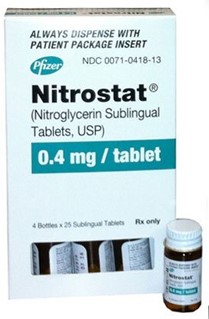A nurse is providing instructions to a client who has a new prescription for sublingual nitroglycerin (Nitrostat) to treat angina pectoris. Which of the following instructions should the nurse include?
Avoid taking the medication prior to exercising.
Stop taking the medication and notify your provider if you develop a headache.
Place the tablet under your tongue, and then take a small sip of water.
The medication can take up to 15 minutes to take effect.
The Correct Answer is C

Nursing Test Bank
Naxlex Comprehensive Predictor Exams
Related Questions
Correct Answer is B
Explanation
Right-sided heart failure is a condition in which the right ventricle fails to pump blood effectively to the lungs, causing a backup of blood in the systemic circulation. This leads to increased pressure in the right atrium and the vena cava, which can be measured by the central venous pressure (CVP). A normal CVP is 2 to 6 mm Hg, but in right-sided heart failure, it can rise above 10 mm Hg. Symptoms of right-sided heart failure include peripheral edema, jugular venous distension, hepatomegaly, ascites, and weight gain.
a. Increased pulmonary artery wedge pressure (PAWP). This statement is incorrect because it describes a finding of left-sided heart failure, not right-sided heart failure. Left-sided heart failure is a condition in which the left ventricle fails to pump blood effectively to the systemic circulation, causing a backup of blood in the pulmonary circulation. This leads to increased pressure in the left atrium and the pulmonary capillaries, which can be measured by the pulmonary artery wedge pressure (PAWP). A normal PAWP is 6 to 12 mm Hg, but in left-sided heart failure, it can rise above 18 mm Hg. Symptoms of left-sided heart failure include dyspnea, orthopnea, paroxysmal nocturnal dyspnea, crackles in the lungs, and pink frothy sputum.
c. Decreased brain natriuretic peptide (BNP). This statement is incorrect because it describes a finding of normal or reduced cardiac function, not heart failure. Brain natriuretic peptide (BNP) is a hormone secreted by the cardiac cells in response to increased stretch and pressure in the ventricles. It acts as a diuretic and a vasodilator, lowering blood volume and blood pressure. BNP is used as a biomarker for diagnosing and monitoring heart failure, as it reflects the degree of ventricular dysfunction. A normal BNP level is less than 100 pg/mL, but in heart failure, it can rise above 400 pg/mL.
d. Decreased specific gravity. This statement is incorrect because it describes a finding of dilute urine, not concentrated urine. Specific gravity is a measure of the concentration of solutes in urine, reflecting the ability of the kidneys to regulate fluid balance. A normal specific gravity is 1.005 to 1.030, but it can vary depending on fluid intake and output, hydration status, and renal function. In right-sided heart failure, fluid retention and reduced renal perfusion can cause oliguria and increased specific gravity of urine.
Correct Answer is ["125"]
Explanation
To calculate the infusion rate, the nurse should use the following formula:
Infusion rate (mL/hr) = Volume (mL) / Time (hr)
Plugging in the given values, the nurse should get:
Infusion rate (mL/hr) = 250 mL / 2 hr
Infusion rate (mL/hr) = 125 mL/hr
The nurse should round the answer to the nearest whole number and use a leading zero if it applies. Therefore, the nurse should set the IV pump to deliver 125 mL/hr.
Whether you are a student looking to ace your exams or a practicing nurse seeking to enhance your expertise , our nursing education contents will empower you with the confidence and competence to make a difference in the lives of patients and become a respected leader in the healthcare field.
Visit Naxlex, invest in your future and unlock endless possibilities with our unparalleled nursing education contents today
Report Wrong Answer on the Current Question
Do you disagree with the answer? If yes, what is your expected answer? Explain.
Kindly be descriptive with the issue you are facing.
